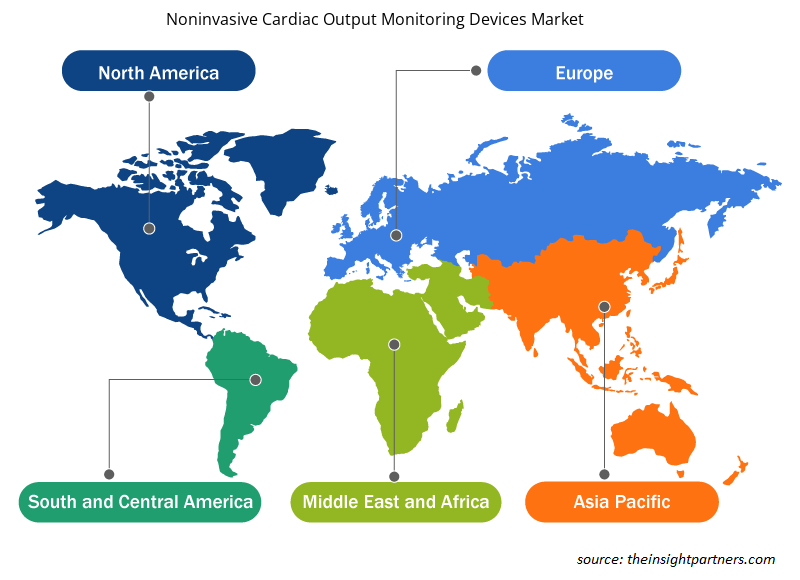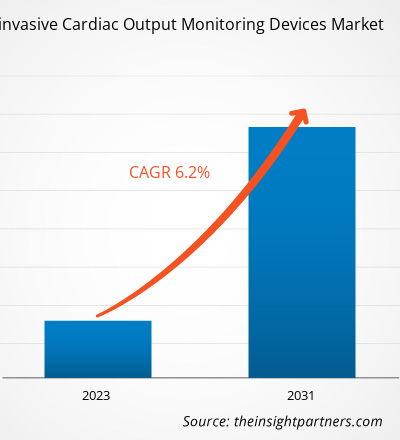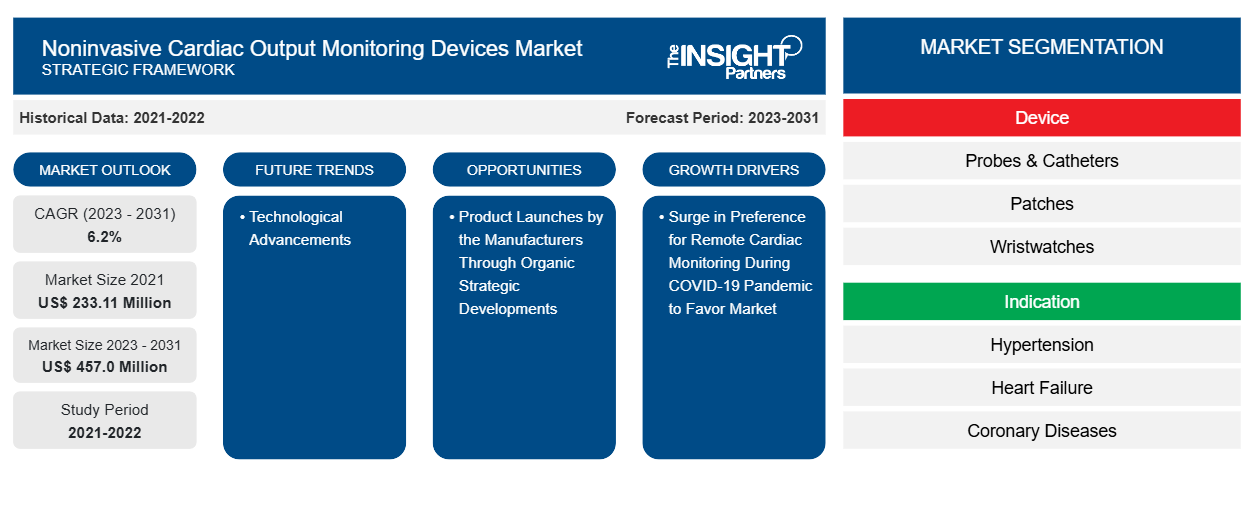Der Markt für nichtinvasive Geräte zur Überwachung des Herzzeitvolumens wurde im Jahr 2021 auf 233,11 Millionen US-Dollar geschätzt und soll bis 2031 457,0 Millionen US-Dollar erreichen. Von 2023 bis 2031 wird für den Markt eine durchschnittliche jährliche Wachstumsrate (CAGR) von 6,2 % erwartet. Technologische Fortschritte werden voraussichtlich weiterhin wichtige Trends auf dem Markt für nichtinvasive Geräte zur Überwachung des Herzzeitvolumens bleiben.
Nichtinvasive Geräte zur Überwachung des HerzzeitvolumensAllgemeine Marktanalyse
Die Messung des Herzzeitvolumens (CO) ist in der medizinischen Praxis unverzichtbar. In der Vergangenheit war die invasive Herzüberwachung der Goldstandard für die Diagnostik. In den letzten Jahren wurden jedoch von den führenden Herstellern medizinischer Geräte mehrere nichtinvasive Geräte zur Überwachung des Herzzeitvolumens entwickelt. Diese Geräte sind technologisch fortschrittliche Produkte, die alternative Lösungen für Herzpatienten bieten, die sich einer invasiven Herzdiagnostik widersetzen.
Marktübersicht für nichtinvasive Geräte zur Überwachung des Herzzeitvolumens
Technologie, Innovation und intelligente technologische Lösungen beeinflussen das Marktwachstum nichtinvasiver Geräte zur Überwachung des Herzzeitvolumens weiterhin erheblich. Der technologische Fortschritt ist ein wichtiger Trend für das Marktwachstum. Neue Produkteinführungen der Hersteller durch organische strategische Entwicklungen werden im Prognosezeitraum lukrative Möglichkeiten für das Marktwachstum nichtinvasiver Geräte zur Überwachung des Herzzeitvolumens bieten.
Passen Sie diesen Bericht Ihren Anforderungen an
Sie erhalten kostenlos individuelle Anpassungen an jedem Bericht, einschließlich Teilen dieses Berichts oder einer Analyse auf Länderebene, eines Excel-Datenpakets sowie tolle Angebote und Rabatte für Start-ups und Universitäten.
-
Holen Sie sich die wichtigsten Markttrends aus diesem Bericht.Dieses KOSTENLOSE Beispiel umfasst eine Datenanalyse von Markttrends bis hin zu Schätzungen und Prognosen.
Nichtinvasive Geräte zur Überwachung des HerzzeitvolumensMarkttreiber und -chancen
Steigende Präferenz für Fernüberwachung der Herzfunktion während der COVID-19-Pandemie
zu Gunsten des Marktes
Technologien zur Fernüberwachung der Herzfunktion von Patienten tragen dazu bei, die Behandlung von Herzerkrankungen neu zu gestalten, indem sie die Gesundheitsversorgung effizienter und zugänglicher machen. So treiben beispielsweise moderne Technologien wie ferngesteuerte Defibrillatoren und Herzschrittmacher die Nachfrage nach Fernbehandlungen der Herzfunktion voran. Die Fernüberwachung der Herzfunktion schreitet mit einem effizienten Gerätedatenmanagement voran, was zur Einführung moderner nichtinvasiver Geräte zur Herzfunktionsüberwachung führt. Außerdem gab es während der COVID-19-Pandemie staatliche Unterstützung für die Fernüberwachung der Vitalfunktionen. So kündigte die USFDA im März 2020 die Zulassung einer erweiterten Nutzung von Geräten zur Fernüberwachung der Vitalfunktionen von Patienten an. Die Zulassung der Fernnutzung von Herzgeräten kann Gesundheitsdienstleistern helfen, auf Informationen über die Vitalfunktionen von Patienten zuzugreifen, während diese zu Hause sind. Dadurch wird die Notwendigkeit von Krankenhausbesuchen verringert und das Risiko einer Ansteckung mit dem neuartigen Coronavirus minimiert. Darüber hinaus haben wichtige Hersteller medizinischer Geräte während der COVID-19-Pandemie innovative nichtinvasive Geräte zur Überwachung der Herzleistung auf den Markt gebracht. So kündigte beispielsweise Octagos Health, ein in Houston ansässiges Gesundheits-Startup-Unternehmen, im Mai 2020 die Einführung einer Fernüberwachungssoftwareplattform der nächsten Generation für Patienten mit implantierten Herzgeräten an. Die Octagon-Software ermöglicht medizinischem Fachpersonal den Zugriff auf Herzpatienten, Herzschrittmacher und Defibrillatoren über ein einziges Portal. Darüber hinaus vereinfacht die Software die Verwaltung von Fernübertragungen und bietet gleichzeitig Patienteneinblicke und -analysen in Echtzeit auf einer sicheren und Cloud-basierten Plattform. Daher wird der Ansatz der Fernüberwachungsgeräte für das Herz erheblich zum Marktwachstum bei nichtinvasiven Geräten zur Überwachung des Herzzeitvolumens beitragen.USFDA announced the allowance of expanded use of devices to monitor patients' vital signs remotely. Allowing remote cardiac devices to be used remotely can help healthcare providers access information about patients’ vital signs while the patient is at home, reducing the need for hospital visits and minimizing the risk of novel coronavirus exposure. Furthermore, key Octagos Health, a Houston-based healthcare startup company, announced the launch of a next-generation remote monitoring software platform for patients with implanted cardiac devices. The Octagon software allows healthcare professionals access to cardiac patients, pacemakers, and defibrillators using one portal. Also, the software simplifies the management of remote transmissions and simultaneously provides real-time patient insights and analytics in a secure and cloud-based platform. Therefore, the remote cardiac monitoring devices approach will contribute significantly to the noninvasive cardiac output monitoring devicesmarket growth.
Technologische Fortschritte
Technologische Fortschritte haben Hersteller medizinischer Geräte dazu ermutigt, innovative Produkte zu entwickeln. Neue Technologien bieten wirksame Alternativen zur herkömmlichen Herzüberwachung und erstellen Warnmeldungen für Patienten mit einem Risiko für Herz-Kreislauf-Erkrankungen. Die Mobile Cardiac Telemetry (MCT) ist ein Beispiel für ein technologisch fortschrittliches Produkt zur Herzüberwachung. Das MCT-System unterstützt die Überwachung des Herzzustands von Herzpatienten. Die Patienten tragen den ganzen Tag über einen winzigen Sensor und einen Monitor bei sich. Immer wenn ein Herzereignis auftritt, sendet das MCT die Daten zur Analyse und Reaktion an ein zentrales System. Das System erstellt einen Bericht mit Diagrammen und Trends und teilt ihn den Ärzten des Patienten zur weiteren Behandlung mit. MCT-Systeme können jeden Herzschlag analysieren und Unregelmäßigkeiten im normalen Zustand eines Patienten erkennen, woraufhin eine sofortige Notfallreaktion eingeleitet wird, was sie zu einer der beliebtesten Optionen für die Herzüberwachung macht. Daher entspricht die Einführung solcher technologisch fortschrittlicher nichtinvasiver Geräte zur Überwachung des Herzzeitvolumens den Gesundheitsbedürfnissen eines Patienten, was das Marktwachstum für nichtinvasive Geräte zur Überwachung des Herzzeitvolumens vorantreibt.devicesmarket growth.
Produkteinführungen der Hersteller durch organische strategische Entwicklungen
Hersteller investieren in die Entwicklung innovativer nichtinvasiver Geräte zur Überwachung des Herzzeitvolumens, um Krankenhäuser besser mit Herzpatienten zu vernetzen. Im Folgenden sind einige Entwicklungen der Hersteller aufgeführt.
- Im Juni 2021 brachte Max Healthcare ein Patientenüberwachungssystem auf den Markt, das in ein Gerät mit künstlicher Intelligenz (KI) integriert ist. Es soll das erste im Land sein. Max Healthcare ist einer der größten Gesundheitsdienstleister in Indien mit über 15 Krankenhäusern für hochspezialisierte Medizin, Diagnostik und integrierten häuslichen Pflegediensten. Das Unternehmen hat den KI-gestützten Patientenüberwachungsdienst in Zusammenarbeit mit einem Anbieter digitaler Gesundheitslösungen namens MyHealthcare eingeführt. Das Max MyHealth+-Ökosystem, das in Zusammenarbeit mit MyHealthcare entwickelt wurde, verfügt über integrierte Blutdruckmessgeräte, EKG- und Herzfrequenzgeräte sowie Blutzuckermessgeräte.
- Im Mai 2021 brachte VitalConnect, Inc., ein führender Anbieter von Biosensortechnologie für die Fern- und Krankenhausüberwachung, die mobile Herztelemetrielösung (MCT) VitalPatch RTM auf den Markt. Es handelt sich um die einzige verfügbare Herzüberwachungslösung mit einer flexiblen, programmierbaren Plattform, die mehrere Herzüberwachungsanforderungen abdeckt. Die Plattform ist einzigartig und nur bei VitalConnect erhältlich und ermöglicht eine kontinuierliche Erkennung von Herzrhythmusstörungen in Echtzeit bei gleichzeitiger Messung physiologischer Patientenparameter.
Derartige strategische Aktivitäten dürften dem Markt für nichtinvasive Geräte zur Überwachung der Herzleistung im Prognosezeitraum lukrative Möglichkeiten bieten, Innovationen voranzutreiben.
Nichtinvasive Geräte zur Überwachung des Herzzeitvolumens
Marktbericht-Segmentierungsanalyse
Wichtige Segmente, die zur Ableitung der Marktanalyse für nichtinvasive Geräte zur Überwachung des Herzzeitvolumens beigetragen haben, sind Gerät, Indikation und Endbenutzer.
- Basierend auf dem Gerät ist der Markt für nichtinvasive Geräte zur Überwachung des Herzzeitvolumens in Sonden und Katheter, Pflaster und Armbanduhren unterteilt. Das Segment Sonden und Katheter hatte im Jahr 2023 den größten Marktanteil.
- Nach Indikation ist der Markt in Bluthochdruck, Herzinsuffizienz, koronare Herzkrankheiten, Myokardischämie und -infarkt, Arrhythmien, angeborene Probleme und andere unterteilt. Das Segment Bluthochdruck hatte im Jahr 2023 den größten Marktanteil.arrhythmias, congenital problems, and others. The hypertension segment held the largest share of the market in 2023.
- Nach Endverbraucher ist der Markt in Krankenhäuser, Notfallzentren, häusliche Pflege und andere unterteilt. Das Krankenhaussegment hatte im Jahr 2023 den größten Marktanteil.
Marktanteilsanalyse für nichtinvasive Geräte zur Überwachung des Herzzeitvolumens nach geografischen Gesichtspunkten
Der geografische Umfang des Marktberichts zu nichtinvasiven Geräten zur Überwachung der Herzleistung ist hauptsächlich in fünf Regionen unterteilt: Nordamerika, Asien-Pazifik, Europa, Naher Osten und Afrika sowie Süd- und Mittelamerika.
Nordamerika dominierte den Markt für nichtinvasive Geräte zur Überwachung des Herzzeitvolumens. Auf dem nordamerikanischen Markt haben die USA einen beträchtlichen Marktanteil. Die Präsenz führender Hersteller medizinischer Geräte in den USA und die Einführung technologisch fortschrittlicher Produkte durch die Hersteller gehören zu den einflussreichsten Faktoren für das Marktwachstum. Der asiatisch-pazifische Raum wird in den kommenden Jahren voraussichtlich die höchste durchschnittliche jährliche Wachstumsrate verzeichnen.
Nichtinvasive Geräte zur Überwachung des Herzzeitvolumens
Regionale Einblicke in den Markt für nichtinvasive Geräte zur Überwachung des Herzzeitvolumens
Die regionalen Trends und Faktoren, die den Markt für nichtinvasive Herzleistungsüberwachungsgeräte während des Prognosezeitraums beeinflussen, wurden von den Analysten von Insight Partners ausführlich erläutert. In diesem Abschnitt werden auch Marktsegmente und Geografie für nichtinvasive Herzleistungsüberwachungsgeräte in Nordamerika, Europa, im asiatisch-pazifischen Raum, im Nahen Osten und Afrika sowie in Süd- und Mittelamerika erörtert.

- Erhalten Sie regionale Daten zum Markt für nichtinvasive Geräte zur Überwachung des Herzzeitvolumens
Umfang des Marktberichts zu nichtinvasiven Geräten zur Überwachung des Herzzeitvolumens
| Berichtsattribut | Details |
|---|---|
| Marktgröße im Jahr 2021 | 233,11 Millionen US-Dollar |
| Marktgröße bis 2031 | 457,0 Millionen US-Dollar |
| Globale CAGR (2023 - 2031) | 6,2 % |
| Historische Daten | 2021-2022 |
| Prognosezeitraum | 2023–2031 |
| Abgedeckte Segmente |
Nach Gerät
|
| Abgedeckte Regionen und Länder |
Nordamerika
|
| Marktführer und wichtige Unternehmensprofile |
|
Marktteilnehmerdichte für nichtinvasive Geräte zur Herzleistungsüberwachung: Auswirkungen auf die Geschäftsdynamik verstehen
Der Markt für nichtinvasive Herzleistungsüberwachungsgeräte wächst rasant, angetrieben von der steigenden Nachfrage der Endnutzer aufgrund von Faktoren wie sich entwickelnden Verbraucherpräferenzen, technologischen Fortschritten und einem größeren Bewusstsein für die Vorteile des Produkts. Mit steigender Nachfrage erweitern Unternehmen ihr Angebot, entwickeln Innovationen, um die Bedürfnisse der Verbraucher zu erfüllen, und nutzen neue Trends, was das Marktwachstum weiter ankurbelt.
Die Marktteilnehmerdichte bezieht sich auf die Verteilung der Firmen oder Unternehmen, die in einem bestimmten Markt oder einer bestimmten Branche tätig sind. Sie gibt an, wie viele Wettbewerber (Marktteilnehmer) in einem bestimmten Marktraum im Verhältnis zu seiner Größe oder seinem gesamten Marktwert präsent sind.
Die wichtigsten Unternehmen auf dem Markt für nichtinvasive Geräte zur Überwachung des Herzzeitvolumens sind:
- Baxter,
- Bio-Beat,
- GE Healthcare,
- Koninklijke Philips NV,
- Abbott,
- Deltex Medical Limited,
Haftungsausschluss : Die oben aufgeführten Unternehmen sind nicht in einer bestimmten Reihenfolge aufgeführt.

- Überblick über die wichtigsten Akteure auf dem Markt für nichtinvasive Geräte zur Überwachung des Herzzeitvolumens
Nichtinvasive Geräte zur Überwachung des HerzzeitvolumensMarktnachrichten und aktuelle Entwicklungen
Der Markt für nichtinvasive Herzleistungsüberwachungsgeräte wird durch die Erfassung qualitativer und quantitativer Daten nach Primär- und Sekundärforschung bewertet, die wichtige Unternehmensveröffentlichungen, Verbandsdaten und Datenbanken umfasst. Im Folgenden finden Sie eine Liste der Entwicklungen auf dem Markt:
- Im Januar 2021 stellte OMRON Healthcare, Inc. auf der CES 2021 seinen ersten Fernüberwachungsdienst für Patienten vor, zusammen mit neuen digitalen Gesundheitstools, um die Kommunikation zwischen Patient und Arzt zu verbessern und ein aktives Management von Bluthochdruck zu gewährleisten. OMRON stellte in den letzten drei Jahren das erste tragbare Blutdruckmessgerät sowie das erste Blutdruckmessgerät mit integriertem EKG vor. Mit diesen Innovationen verändert das Unternehmen weiterhin den globalen Markt für Herzgesundheit und unterstützt seine Mission „Going for Zero“ (Null Herzinfarkte und Schlaganfälle).
Marktbericht zu nichtinvasiven Geräten zur Überwachung des Herzzeitvolumens – Abdeckung und Ergebnisse
Der Bericht „Marktgröße und Prognose für nichtinvasive Geräte zur Überwachung des Herzzeitvolumens (2021–2031)“ bietet eine detaillierte Analyse des Marktes, die die folgenden Bereiche abdeckt:
- Marktgröße und Prognose für nichtinvasive Geräte zur Überwachung des Herzzeitvolumens auf globaler, regionaler und Länderebene für alle wichtigen Marktsegmente, die im Rahmen des Berichts abgedeckt sind
- Markttrends und Marktdynamiken für nichtinvasive Geräte zur Überwachung des Herzzeitvolumens wie Treiber, Einschränkungen und wichtige Chancen
- Detaillierte PEST/Porters Five Forces- und SWOT-Analyse
- Marktanalyse für nichtinvasive Geräte zur Überwachung des Herzzeitvolumens, die wichtige Markttrends, globale und regionale Rahmenbedingungen, wichtige Akteure, Vorschriften und aktuelle Marktentwicklungen umfasst
- Branchenlandschaft und Wettbewerbsanalyse, die die Marktkonzentration, Heatmap-Analyse, prominente Akteure und aktuelle Entwicklungen auf dem Markt für nichtinvasive Geräte zur Herzleistungsüberwachung umfasst
- Detaillierte Firmenprofile
- Historische Analyse (2 Jahre), Basisjahr, Prognose (7 Jahre) mit CAGR
- PEST- und SWOT-Analyse
- Marktgröße Wert/Volumen – Global, Regional, Land
- Branchen- und Wettbewerbslandschaft
- Excel-Datensatz
Aktuelle Berichte
Erfahrungsberichte
Grund zum Kauf
- Fundierte Entscheidungsfindung
- Marktdynamik verstehen
- Wettbewerbsanalyse
- Kundeneinblicke
- Marktprognosen
- Risikominimierung
- Strategische Planung
- Investitionsbegründung
- Identifizierung neuer Märkte
- Verbesserung von Marketingstrategien
- Steigerung der Betriebseffizienz
- Anpassung an regulatorische Trends























 Kostenlose Probe anfordern für - Markt für nichtinvasive Geräte zur Überwachung des Herzzeitvolumens
Kostenlose Probe anfordern für - Markt für nichtinvasive Geräte zur Überwachung des Herzzeitvolumens